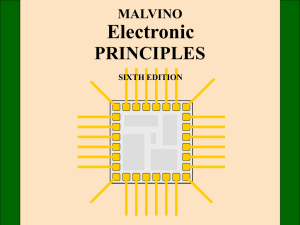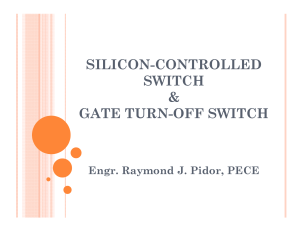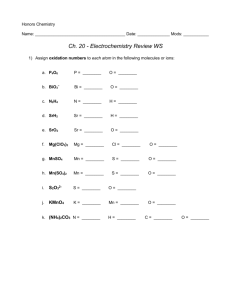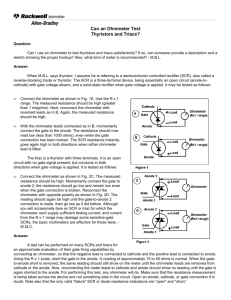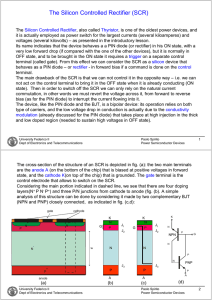SCR/Thyristor: Structure, Function & Applications
advertisement
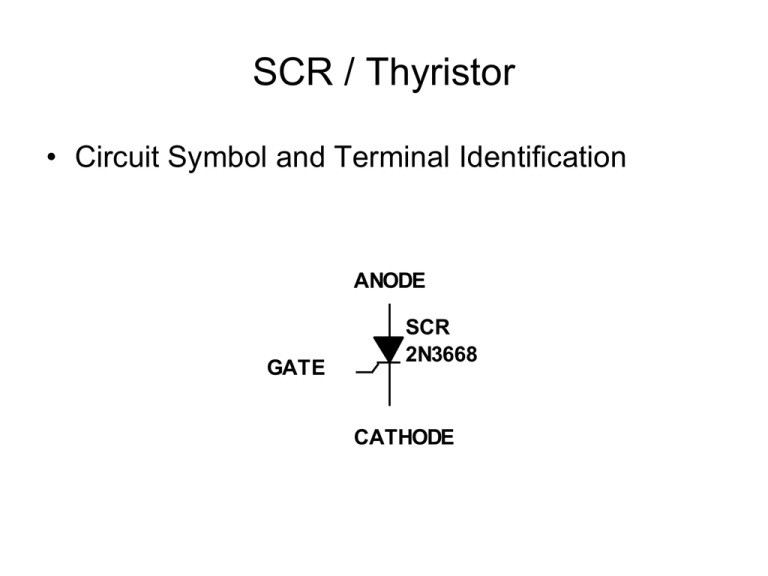
SCR / Thyristor • Circuit Symbol and Terminal Identification ANODE GATE SCR 2N3668 CATHODE SCR / Thyristor • Anode and Cathode terminals as conventional pn junction diode • Gate terminal for a controlling input signal ANODE GATE SCR 2N3668 CATHODE SCR/ Thyristor • An SCR (Thyristor) is a “controlled” rectifier (diode) • Control the conduction under forward bias by applying a current into the Gate terminal • Under reverse bias, looks like conventional pn junction diode SCR / Thyristor Anode • 4-layer (pnpn) device • Anode, Cathode as for a conventional pn junction diode • Cathode Gate brought out for controlling input P N Gate P N Cathode ANODE Equivalent Circuit ANODE P Q1 N N BJT_PNP_VIRTUAL GATE P Q2 P GATE BJT_NPN_VIRTUAL N CATHODE CATHODE Apply Biasing Variable 50V With the Gate terminal OPEN, both transistors are OFF. As the applied voltage increases, there will be a “breakdown” that causes both transistors to conduct (saturate) making GATE (G) IF > 0 and VAK = 0. IF ANODE (A) Q1 IC2=IB1 BJT_PNP_VIRTUAL IC1 = IB2 Q2 BJT_NPN_VIRTUAL VBreakdown = VBR(F) IF CATHODE (K) Volt-Ampere Characteristic IF Holding Current IH VBR(F) VAK Breakdown Voltage Apply a Gate Current For 0 < VAK < VBR(F), Variable 50V Turn Q2 ON by applying a current into the Gate IF ANODE (A) Q1 This causes Q1 to turn ON, and eventually both transistors SATURATE VAK = VCEsat + VBEsat IC2 = IB1 BJT_PNP_VIRTUAL GATE (G) IB2 Q2 BJT_NPN_VIRTUAL If the Gate pulse is removed, Q1 and Q2 still stay ON! VG IF CATHODE (K) How do you turn it OFF? • Cause the forward current to fall below the value if the “holding” current, IH • Reverse bias the device SCR Application – Power Control XSC1 G A B T R 25kOhm Key = a Vs 170V 120.21V_rms 60Hz 0Deg 60% When the voltage across the capacitor reaches the “trigger-point” voltage of the device, the SCR turns ON, current flows in the Load for the remainder of the positive half-cycle. D1 2N1776 Rload 15ohm C 0.01uF Current flow stops when the applied voltage goes negative. Input / Output Voltages Look at the LOAD Current Conduction time Conduction Angle = 180 - “Firing” time Firing Angle () Average Load Current i 1 V sin td (t ) 2 R V (1 cos ) 2 R p L ,A V E LOA D i p L ,A V E L t an (R C ) 1

